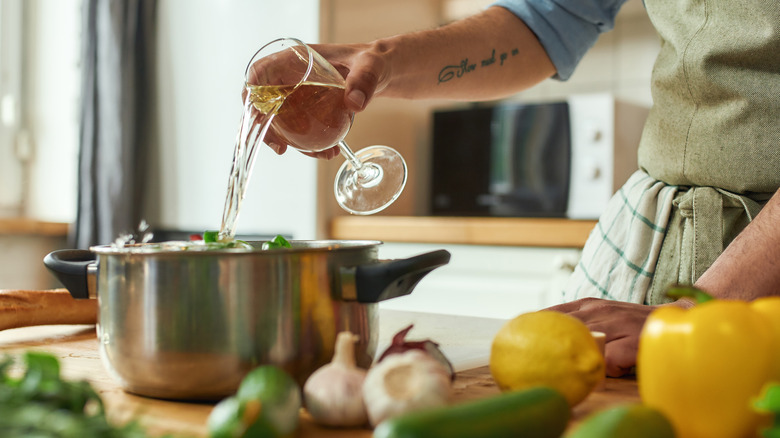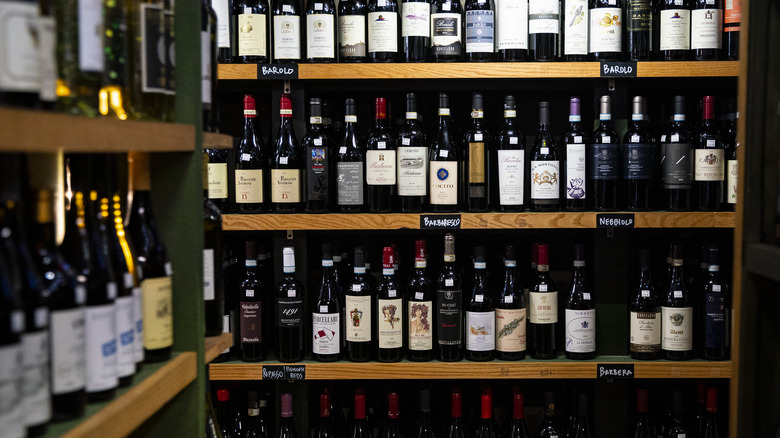The Reason You Shouldn't Cheap Out On Wine For Cooking
Cooking with wine can elevate a dish from meh to marvelous. But if you're reaching for the cheapest bottle on the shelf, you might want to reconsider. Here's why: Cheap wine typically comes with cheap flavors that'll infuse into your food. And let's be real, no one wants their dish to taste like what's on the bottom shelf at the liquor store.
If you wouldn't drink it, why would you want to cook with it? Cheaper varieties of wine often lack the depth and complexity of finer labels and are made using different techniques that can result in sterile, flat, and sugary notes that will dull the bright flavors of your dish. When cooking with wine, you want to enhance the natural flavors of your ingredients, not mask them. So, while it may seem like a smart money-saving tactic to use that $5 bottle of vino, it could be the downfall of your culinary masterpiece.
Remember, a good meal is worth the investment. So the next time you're at the store, don't just grab the cheapest bottle you can find. Think about the final result and invest in a wine that will enhance the flavor and texture of your dish. But if you're on a budget, don't worry. We're not saying you need to go out and buy the most expensive bottle on the market. There are plenty of great, reasonably-priced wines that can enhance the flavors in your dish without breaking the bank.
Cheap wine vs. expensive wine
So, what exactly differentiates a cheap wine from a better-quality one? For starters, cheap wines tend to be made from lower-quality grapes. These wines are often mass-produced, with shortcuts taken in the winemaking process that result in a less-than-stellar product. Wines that command a higher price are typically made from carefully-selected grapes that are handled with care at every step of the process and aged to perfection.
The oak barrels used for aging can also make a difference in the quality of the wine and, in turn, the dish you're cooking. Oak barrels impart a complex flavor profile to the wine, with notes of vanilla, spice, and even smoke. Cheaper wines may be aged in stainless steel or less-expensive oak barrels, giving them a less nuanced flavor profile.
Meanwhile, avoid wines labeled as "cooking wine" or "table wine," which are often low-quality and loaded with added salt. The higher alcohol content of these wines can also affect the texture of your dish and might make it too acidic.
What kind of wine to cook with
When it comes to choosing a wine to cook with, avoid looking at the price tag first and start by considering the varietal. For example, if you're making a rich beef stew, a full-bodied red wine like Cabernet Sauvignon will pair well and add depth of flavor to the dish (just be mindful of how oaky it is, as this note can sometimes become bitter when cooked down). For lighter dishes like seafood or chicken, a crisp white wine such as Sauvignon Blanc can brighten the dish and add citrusy notes.
There are plenty of budget-friendly wines that are still high-quality. For red wine, try a Tempranillo from Spain or a Malbec from Argentina. These wines have rich fruit flavors and typically won't break the bank. For whites, go for a crisp, dry Chardonnay from California or a Chenin Blanc from South Africa.
The real key is to consider what you'd like to enjoy a glass of once your meal is finished. Don't get too bogged down in specifics — just try to avoid super cheap wine if you can. Case in point: Lauren Salkeld, a cookbook writer, editor, and recipe developer, told Wine Enthusiast that she doesn't have a particular wine she uses all the time. "I use red or white, depending on what I am cooking," she said. "I've even been known to use rosé or bubbles, because I hate to let things go to waste!"


